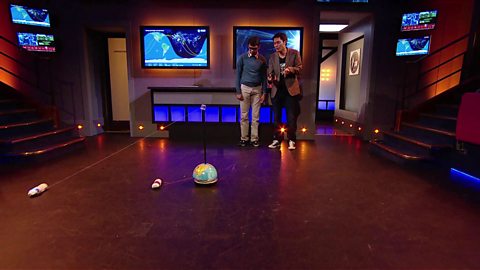Kevin Fong explains that modern tablet computers and mobile phones can tell which way is up using accelerometers.
Humans have a much more sensitive system for detecting movement and orientation and this is located within the inner ear.
The three semi-circular canals detect rotational acceleration and the adjacent swelling contains two linear accelerometers.
However, the inner ear relies on gravity as a reference, so astronauts commonly suffer from disorientation during the first few days in the International Space Station.
Kevin uses a volunteer from the audience to demonstrate this, by spinning the student on a swivel chair with his head inclined to one side and his eyes closed.
He becomes extremely dizzy.
This clip is from the Royal Institution Christmas Lectures 2015.
Teacher Notes
Key Stage 3
Before watching the clip, you could ask students how many of them get travel sickness and if they know what typically causes it.
How many of them enjoy fairground rides? If it is safe to do so, the demonstration could be repeated in the lesson, but care should be taken before allowing the volunteer to stand up.
Key Stage 4
After watching this clip, students could research motion sickness or dizziness on fairground rides.
Is it true that adults do not enjoy fairground rides as much as children (opportunity for investigative survey) and is there a scientific explanation for this?
Curriculum Notes
This clip will be relevant for teaching Physics.
This topic appears at KS3 and in OCR, Edexcel, AQA, WJEC KS4/GCSE in England and Wales, CCEA GCSE in Northern Ireland and SQA National 4/5 in Scotland.
More from the Royal Institution Christmas Lectures 2015
What is Newton's Cannon and Third Law? video
Dr Kevin Fong demonstrates projectile motion, orbit and Newton’s Third Law.

Using Earth’s rotation to launch a rocket. video
Dr Kevin Fong demonstrates how a space rocket’s launch direction affects its success in reaching orbit.

How the vacuum of space affects the human body. video
Dr Kevin Fong does a demonstration to show the lethal effects of a vacuum on the human body.

Resonant Frequency. video
Dr Kevin Fong explains how sound vibrations could pose a real threat astronauts and rockets in space.

Orbital Rendezvous. video
Dr Kevin Fong demonstrates how and why it's so hard for a spacecraft to catch up with the International Space Station.

What does gas weigh? video
A demonstration that carbon dioxide can be poured because it is denser than air.

Why are bones weaker in orbit? video
Kevin Fong explains how micro-gravity can weaken bones. Models are used to show that bones are strong but light, and how low gravity weakens them.

The danger of orbital debris. video
Dr Kevin Fong and NASA astronaut Dan Tani explain the danger of space debris.

Demonstrating heat shield material. video
Dr Kevin Fong explains that space capsules heat up due to pressure not friction. He demonstrates a heat shield’s low thermal conductivity.

Why Earth rock is found on the Moon. video
Dr Kevin Fong demonstrates how debris from meteorites hitting Earth threw Earth rock as far as the Moon, leaving clues there about Earth’s geological history.

Demonstrating radiation detectors. video
Dr Kevin Fong shows how a Geiger-Muller tube can detect ionising radiation but not the type of radiation, and how detectors on the International Space Station can.

How Earth protects us from radiation. video
Dr Kevin Fong discusses the dangers to astronauts of solar radiation, and how we’re protected from it by Earth’s atmosphere and magnetic field.

Why tardigrades can survive in orbit. video
Dr Kevin Fong explains why tardigrades are so resilient when exposed to ionising radiation lethal to most other organisms.

How to recycle urine in space. video
Dr Kevin Fong demonstrates a urine recycling system that works using osmosis, concluding by drinking the liquid that is produced.

Мэ